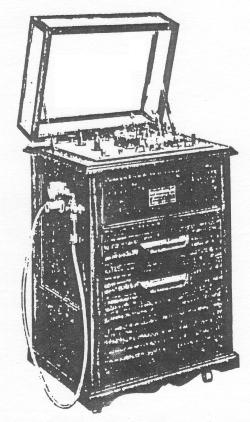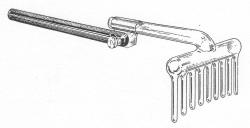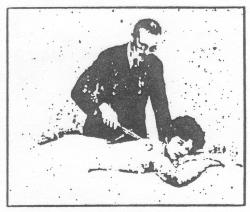

It is certainly a great improvement over the old method,
which required the patient to hold the handle almost at arm’s length.
The electrode is placed in the ear and the machine started
with a minimum of current. The strength is then increased in accordance
with the tolerance of the patient to the point where the buzzing sound
becomes annoying, or the fine sparks become to sharp. With the insulated
tube, the sparks coming from loose contact with the external opening are
avoided. A marked sensation of heat is noticed in the ear, and the
best method of regulating the length of treatment is to allow the tube
to remain until this heat effect becomes a little uncomfortable, although
I would never under any ordinary circumstances continue the treatment longer
than seven minutes.
I designed a holder a few years ago which permitted treating
both ears at the same time, but for all ordinary conditions this is scarcely
necessary, as the additional time required in treating the other ear where
both require treatment is not sufficient to interfere seriously.
The conditions of the ear in which high frequency currents give the best
results are catarrhal deafness; earache; tinnitus aurium, and chronic suppurative
diseases (middle ear diseases).



Special Technique in Treating the Eyes. For
applying high frequency currents to the eye, a double electrode is used,
as shown in Fig. 46, which is inserted in the handle and the socket bent
so that the patient may hold the handle against the body and thus steady
it, and at the same time keep the electrode in contact with the eyes, without
taking any chances of touching the cord connecting the electrode to the
high frequency apparatus. This is shown in Fig. 47. The eyes
are closed and the tube kept in light but firm contact with the lids.
The current is turned on after the tube is adjusted and is turned off before
the electrode is removed, thus saving the patient from any spark.
The duration of the application varies from three to ten minutes.
If only one eye is affected, only one lobe of the tube may be brought in
contact with the eye and the other may extend out to one side of the head,
or a special single eye tube may be used. One of the other vacuum
tubes may be employed in treating the eye and kept in motion back and forth
over the closed lid, or held in contact with it as preferred. This
method with a fine spark has proved very effective in blepharitis.
These currents are useful in atrophy of the optic nerve;
catarrhal conditions of the eye; absorption of hemorrhages; inflammation
of the retina, and in connection with auto-condensation for the reduction
of the blood pressure, they have given remarkable results in glaucoma.
Blepharitis, trachoma, iritis, paralysis of the ocular muscle, and cataract,
are other conditions in which they have been employed.
Nasal Technique. The diseases of the nose
that are specially suitable for treatment are all catarrhal conditions,
including ozena (atrophic rhinitis), coryza, etc. Even in hay-fever
it has proved useful. The small nasal tube (Fig. 48 or Fig.21, No.
13) is introduced and the current turned on very slowly. A mild current
is all that is required and the length of treatment varies from two or
three to seven minutes. It makes very little difference whether the
tube is inserted in the straight or the movable socket handle. If
the upper or back part of the nasal cavity is to be treated, a tube having
an insulated chamber to within possibly three-quarters of an inch or an
inch of the end is preferable to the non-insulated tube. In acute
inflammatory conditions the application of a vacuum electrode to the sides
of the nose, externally, is advised.
Technique in Treatment of Rectum and Prostate.
In treating the rectum for fissure, hemorrhoids, catarrhal conditions,
etc., the insulated tube shown in Fig. 21, No. 8, should be used.
The non-insulated tube is of much less value for diseases above the sphincter.
The rectal tube may be employed in treating the prostate, although the
tube specially designed for the latter purpose is the one shown in Fig.
21, No. 1, where the depression in the tube is supposed to be turned toward
the anterior wall of the rectum, and receive into it a portion of the gland.
My new spatulate tube used with one of the flat surfaces toward the prostate
gives a larger contact surface, it being doubtful whether with the other
tube the gland really ever fits into the depression. In prostatic
diseases of all kinds, the high frequency current has proved most efficacious,
whether used alone or in connection with some other modality.

In treating both the rectum and the prostate, my special
technique consists in placing the patient on one side in the Sims’ position
with the knees well drawn up. The electrode is lubricated, inserted
in the movable socket handle and introduced into the rectum. The
handle is then bent upwards in contact with the body and the patient takes
hold of the handle, thus keeping the tube in place during the treatment.
The duration of each treatment is seven minutes, and the tube is inserted
always before turning on the current and the latter turned off before the
tube is removed. Treatment through the rectum is very effective in
posterior urethritis, also in diseases of the bladder. Occasionally
in virgins it will be found desirable to treat uterine or vaginal conditions
with the high frequency electrode in the rectum. The current penetrates
surrounding structures to a much greater extent than one would suppose.
The special technique for itching is given in Chapter
VIII under pruritus
Scalp Treatment. In treating the scalp, the
body electrode, Fig.49, is used. The electrode is moved rapidly back
and forth over the scalp using a spark of from one-quarter to three-quarters
of an inch or keeping the tube in light contact with the scalp. If
too sharp a spark is used, the scalp will be sore after the treatment and
tiny sores will be found. High frequency currents are indicated in
all diseases of the scalp, in falling hair, and some years ago I made the
discovery that if employed for a sufficient length of time they are capable
of restoring the color to gray hair. This will be specially considered
in Chapter VIII. The tube shown in Fig. 21, No. 11, is used conveniently
in treating the scalp, being equally as good as the body tube, and a new
tube resembling a glass rake is now in general use. Fig. 49a.

Throat Technique. The throat electrode is
shown in Fig. 50. Any of the other electrodes may be used externally.
In acute inflammatory conditions of the throat the low vacuum tube is preferable.
The tube may be placed directly in contact with the mucous membrane of
the throat or a spark allowed to pass, according to the nature of the case.
Sparks from the regular tube or from the fulguration point have been employed
to destroy follicles in pharyngitis or in place of nitrate of silver cauterization,
and the fulguration point has even been used in the removal of the tonsils.

Urethral Technique. When employing glass sounds
(Fig. 20, No. 5, or Fig. 21, No. 12) within the male urethra, the patient
is placed upon his back on the operating table. Whether the knees
are flexed and the legs drawn up depends somewhat upon the individual case;
ordinarily the legs are straight, but slightly separated.
The sterilized sound is lubricated and introduced in the
same manner that a steel sound would be used, taking care, however, not
to use much force, on account of the possibility of breaking the tube.
This has happened occasionally, through a prying or sidewise motion, or
through a sudden jerk.
If the canal is too small to admit of the easy passage
of the tube, steel sounds are used first to dilate the urethra to sufficient
size.
In case stricture is present and the whole canal cannot
be dilated sufficiently to allow the glass tube to pass the stricture,
then it is introduced as far as the stricture and the treatment given.
On subsequent days it will be found that the stricture gradually disappears
until finally the glass tube will pass by it.
When the urethral tube has been properly inserted, the
socket of the holder is slipped over it, and the handle bent back over
the patient’s abdomen.
The patient takes hold of it and thus steadies the tube.
In stricture he is instructed to make steady downward pressure to keep
the point of the tube firmly in contact with the stricture. The handle
is connected to the machine and the current turned on. In this way
the patient experiences no shock. The current is turned off before
the sound is removed. Duration of treatment, seven minutes.
Do not forget that the posterior urethra may be treated
almost as thoroughly and with much less pain, by introducing a tube into
the rectum.
Uterine and Vaginal Technique. High frequency
currents are suitable in all catarrhal conditions of uterus and vagina,
including leucorrhea, cervicitis endometritis, etc. They are extremely
valuable in specific vaginal diseases in conjunction with the usual method.
Treatment through the vagina is also indicated in diseases of the fallopian
tubes and of the ovaries and in pelvic abscess and in adhesions.
Low or medium vacuum tubes should be used in the latter diseases.
The technique which I use in applying the current in the
vagina, is as follows: The patient is placed on her back with her feet
in the stirrups and the lubricated tube in the author’s movable socket
holder is inserted, and then the handle is bent down to touch the table
and the patient’s skirts folded over it, thus anchoring the tube and preventing
it from slipping out. A towel is then wrapped around the metal connection
between the tube and handle to prevent the latter from tipping sideways
and thus giving the patient an uncomfortable spark. The cord connecting
with the generating apparatus passes out under one leg of the patient and
care should be exercised to see that it does not come in contact with it,
nor should it rest upon any metal which touches the patient, for if there
be a defect in insulation a sharp current will be communicated along the
metal. After the tube is properly adjusted the current is turned
on and allowed to pass for seven minutes, when it is turned off before
removing the tube. In very acute cases, I have not hesitated to give
two ro three treatments in a day until improvement took place. Ordinarily
from one treatment a day down to two or three treatments a week will prove
satisfactory in sub-acute or chronic cases. The insulated vaginal
tube should be used. It is shown in Fig. 21, No. 10. The prostatic
tube also makes an excellent one for vaginal use, and Fig. 27 shows my
new spatulate tubes, which admit of contact with a larger surface.
Occasionally in treating diseases of the cervix, a small electrode may
be inserted within the canal, taking care to insulate against contact with
the metal speculum, if the latter is used. (An old-fashioned glass
one is better.) In cancer, the fulguration tube may be used through
the vagina to destroy the cancerous tissue. This may or may not require
an anaesthetic.

One authority packs the vagina with moistened gauze with
a metal electrode in the center and thus carries the current to all contiguous
parts. The D’Arsonval current may be used in the vagina by this method.
Direct D’Arsonvalization is now known as diathermy. See Chapter XI